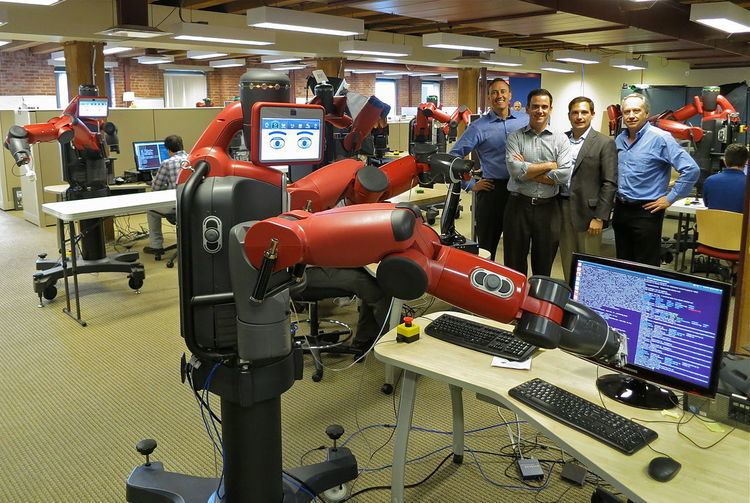Website rethinkrobotics.com | Year of creation 2012 Purpose simple industrial jobs | |
 | ||
Baxter is an industrial robot predecessor to Sawyer (cobot) built by Rethink Robotics, a start-up company founded by Rodney Brooks. It was introduced in September 2012. Baxter is a 3-foot tall (without pedestal; 5'10" – 6'3" with pedestal), two-armed robot with an animated face. It weighs 165 lbs without the pedestal and 306 lbs with the pedestal. It is used for simple industrial jobs such as loading, unloading, sorting, and handling of materials. Brooks stated that Baxter was designed to perform the dull tasks on a production line. It is intended to be sold to small and medium-sized companies.
Contents
Technology
Baxter has an animated screen for a face that allows Baxter to express itself through several facial expressions. Its face can show what it is focused on, and its current status. Baxter can even express its confusion when something isn't right. Baxter also has sensors surrounding its head that allow it to sense people nearby. Other sensors around its head give the Baxter Research Robot the ability to adapt to its environment, unlike other industrial robots which will either continue to do their one task repeatedly, or will shut down and stop working at the slightest change in their environment. For example, Baxter is adaptive enough to know that it cannot continue with its job if it drops a tool, whereas some robots will simply continue to attempt to perform their job despite lacking the proper tools. Baxter runs on the open-source Robot Operating System on a regular, personal computer which is embedded in its chest. Baxter can be placed on a four-legged pedestal with wheels to become mobile. Baxter also has extra sensors in its hands that allow it to pay very close attention to detail.
Teaching Baxter
Baxter can be programmed through moving its hand to perform a task in the desired motion. Baxter will memorize and be able to repeat the task. Extra dials, buttons, and controls are available on Baxter's arm for more precision and features. Any regular worker could program Baxter and it only takes a matter of minutes, unlike usual industrial robots that take extensive programs and coding in order to be used. This means Baxter isn't programmed by traditional software engineers writing code. This also means Baxter can be taught to perform multiple, more complicated tasks.
Research
Many universities are now using Baxter as part of their courses within Robotics, Mechanical Engineering and Computational Sciences to give students the experience using current robotics technology to provide practical applications in the real world. Baxter provides many advantages over traditional robots in that no cages are required for usage and students can work alongside him in a classroom environment without the potential for accidents. This feature is also useful for Baxter's application in commercial usage. Researchers are now using the Baxter robot to try to find solutions to current problems being faced by Ebola workers in West Africa to create a robotic solution to reduce risk of infection for aid workers. Currently, the head mounted camera, sonar head sensors, and IR hand lighting is only available for use on the Research Robot model of Baxter.
Safety
Other industrial robots are built to perform one task rapidly with many fast-moving parts that make them unsafe for working alongside humans. Baxter has sensors in its hands and around its arms allowing it to detect and adapt to its surroundings. This enables it to sense potential collision events early, and can reduce the force before the impact. This is due to a motor driving a spring, and that spring driving Baxter's arm instead of just a motor driving its arms. Extra sensors and cameras within Baxter's hands allow it to pay attention to detail while working with its hands. These extra sensors and abilities that Baxter has means that it does not need to be put into a safety cage.
Cost
Baxter has a base-price of $25,000 (£19,000/ €22,000), the equivalent of an average US production worker's annual salary. In addition, no programming or software engineer is needed to program Baxter. Rethink Robotics also sells additional parts, such as an electric parallel gripper, a vacuum cup gripper and the mobile pedestal, to add to a customer's Baxter, as well as extended warranties.
Controversy
Some people are concerned about the introduction of Baxter into production lines, and think Baxter takes away low-wage manual labor jobs. One the other hand, some people say Baxter does not take jobs because humans are still needed to supervise and teach Baxter to perform tasks.
According to Rodney Brooks, Baxter is not a threat to human jobs because Baxter's ability is limited in tasks such as quality assurance or small assembly where things like sensing tension are important. In those cases, a human is unlikely to be replaced by robots like Baxter. Ideally, the robot is designed to do repetitive tasks and the people do the tasks they are better at. Together, the factory excels.
